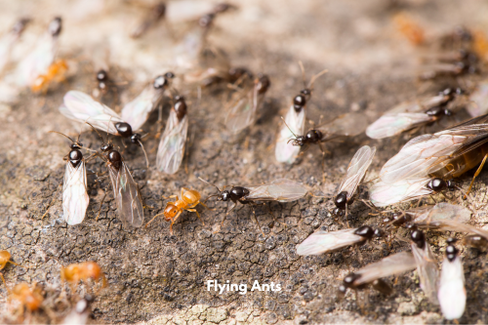Flying Ants vs. Termites - How To Spot the Differences
- Eco Pest Bermuda

- May 8, 2024
- 3 min read
Updated: Jan 27

Whether you’ve noticed unusual flying insects around your property or heard the stories of damage they can cause, understanding the differences between flying ants and swarming termites is important for every homeowner or business operator. These two pests, may seem similar at a glance, but each can have very different impacts on your property. Here's what you need to know to identify, understand, and manage these winged intruders.
Physical Appearance and Behaviour of Flying Ants
Flying ants, also known as winged ants, are actually just regular ants that have reached their reproductive stage. These ants develop wings in order to mate and establish new colonies. They are often seen flying in large groups, or swarms, during the spring and summer months.
One key characteristic of flying ants is their waist, which is noticeably constricted. They also have bent antennae and unequal wing lengths, with the front pair being longer than the back pair. Flying ants are typically black or dark brown in colour, but can also be reddish-brown or yellowish-brown.
Flying ants are attracted to light sources and will often gather around windows and light fixtures. After mating, the male ants die and the female ants shed their wings before starting a new colony.
Physical Appearance and Behaviour of Swarming Termites
Swarming termites, on the other hand, are much smaller in size compared to flying ants. They have straight antennae and equal-sized wings that are longer than their body. Their bodies also have a more uniform shape compared to flying ants.
In contrast to flying ants, swarming termites do not have a constricted waist and their wings are easily shed once they find a suitable place to establish a new colony. They are also attracted to light sources but can often be found near areas with high moisture levels, as they require moist environments to survive.
Damage Caused by Flying Ants and Swarming Termites
While both flying ants and swarming termites can cause damage to properties, their methods differ. Flying ants do not typically cause structural damage and are more of a nuisance pest, while swarming termites are known for causing extensive damage to wooden structures.
Flying ants may enter your home or business looking for food, but they do not typically nest inside buildings. On the other hand, swarming termites can cause severe damage to wooden structures and may even lead to structural failure if left untreated.
Prevention and Control
To prevent these flying pests from entering your property, it is important to seal any cracks or openings around windows, doors, and foundations. Keeping your home or business clean and free of food crumbs will also discourage flying ants from entering.
For swarming termites, it is important to fix any moisture issues in and around your property. This includes repairing leaks, improving ventilation, and removing any standing water sources. It is also recommended to have regular termite inspections and treatments from a professional pest control company, such as Eco Pest.
If you see flying insects in and around your property, contact Eco Pest today to have our Team properly identify the pest and recommend the specific treatments to eliminate them.
Did you know that Eco Pest Ltd monitors every fumigation? That’s right, we have specialist equipment to track the level of fumigant within the structure for the whole process. This means that we know for sure that we are getting the treatment done right every time.












